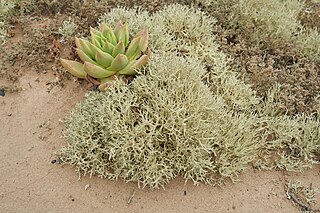
A depside is a type of polyphenolic compound composed of two or more monocyclic aromatic units linked by an ester group. Depsides are most often found in lichens, but have also been isolated from higher plants, including species of the Ericaceae, Lamiaceae, Papaveraceae and Myrtaceae.

Niebla, also known as the sea-fog lichens, is a genus of yellow-green fruticose lichens that grow on rocks, trees, and shrubs within the fog zone of coastal North America, or more narrowly defined to occur on rocks and soil along the Pacific Coast from Mendocino County in California south to Baja California Sur.
A spot test in lichenology is a spot analysis used to help identify lichens. It is performed by placing a drop of a chemical reagent on different parts of the lichen and noting the colour change associated with application of the chemical. The tests are routinely encountered in dichotomous keys for lichen species, and they take advantage of the wide array of lichen products produced by lichens and their uniqueness among taxa. As such, spot tests reveal the presence or absence of chemicals in various parts of a lichen. They were first proposed as a method to help identify species by the Finnish lichenologist William Nylander in 1866.

Depsidones are chemical compounds that are sometimes found as secondary metabolites in lichens. They are esters that are both depsides and cyclic ethers. An example is norstictic acid.

Norstictic acid is a depsidone produced as a secondary metabolites in lichens.

Niebla arenaria is a fruticose lichen that grows along the Pacific Coast of North America in the fog regions of the northern peninsula of Baja California from near Colonet south to Morro Santo Domingo. The epithet, arenaria, is in regard to the species growing on sand.
John Alan (Jack) Elix emeritus professor in chemistry at the Australian National University, is an organic chemist who has contributed in many fields: lichenology, lichen chemotaxonomy, plant physiology and biodiversity and natural product chemistry. He has authored 2282 species names, and 67 genera in the field of mycology. Elix edited the exsiccata series Lichenes Australasici exsiccati.

Salazinic acid is a depsidone with a lactone ring. It is found in some lichens, and is especially prevalent in Parmotrema and Bulbothrix, where its presence or absence is often used to help classify species in those genera.
Ocellularia aptrootiana is a species of corticolous lichen in the family Graphidaceae. Found in Sri Lanka, it was formally described as a new species in 2014 by lichenologists Gothamie Weerakoon, Robert Lücking, and Helge Thorsten Lumbsch. The type specimen was collected from Mahailluppallama at an altitude of 170 m (560 ft). Here, in a low-altitude, dry, semi-evergreen forest, it was found growing around a water tank. The specific epithet aptrootiana honours Dutch lichenologist André Aptroot, "for his important contributions to tropical lichenology and his help with the research by the first author". Ocellularia aptrootiana has a grey, smooth to uneven or cracked thallus up to convert 5 cm (2 in) in diameter. The ascospores are hyaline, ellipsoid in shape, contain seven septa, and measure 20–25 by 6–7 μm. Secondary chemicals present in the lichen include psoromic acid, subpsoromic acid, and 2’-O-demethylpsoromic acids.
Ocellularia balangoda is a species of corticolous lichen in the family Graphidaceae. Found in Sri Lanka, it was formally described as a new species in 2014 by lichenologists Gothamie Weerakoon, Robert Lücking, and Helge Thorsten Lumbsch. The type specimen was collected from a high-altitude tea estate in Hunnasgiriya at an altitude of 1,240 m (4,070 ft); here it was found growing on tree trunks. The specific epithet refers to the prehistoric hominids known as Balangoda Man, who lived in Sri Lanka about 38,000 to 28,500 years ago. Ocellularia balangoda has a grey thallus up to 5 cm (2 in) in diameter, with a papillose (pimply) to verrucose (warty) textured surface. The ascospores are hyaline, ellipsoid in shape, contain seven septa, and measure 25–30 by 5–7 μm. Secondary chemicals present in the lichen include protocetraric acid and virensic acid.
Ocellularia cloonanii is a species of corticolous lichen in the family Graphidaceae. Found in Sri Lanka, it was formally described as a new species in 2014 by lichenologists Gothamie Weerakoon, Robert Lücking, and Helge Thorsten Lumbsch. The type specimen was collected from a high-elevation montane forest in the Fishing Hut Tea Estate at an altitude of 1,870 m (6,140 ft). The lichen is only known to occur at the type locality in the Horton Plains. The specific epithet cloonanii honours Colman Patrick Cloonan, "for his immense help in carrying out the research studies". Ocellularia cloonanii has an olive-grey thallus up to 5 cm (2 in) in diameter, with continuous but uneven surface. Its ascospores are hyaline, ellipsoid in shape, contain seven to nine septa, and measure 35–40 by 7–10 μm. Secondary chemicals present in the lichen include psoromic acid, subpsoromic acid, and 2’-O-demethylpsoromic acid.
Ocellularia raveniana is a species of corticolous lichen in the family Graphidaceae. Found in Sri Lanka, it was formally described as a new species in 2014 by lichenologists Gothamie Weerakoon, Robert Lücking, and Helge Thorsten Lumbsch. The type specimen was collected from a high-elevation tea estate in Matale at an altitude of 1,360 m (4,460 ft). The lichen is only known to occur at the type locality and in the Sabaragamuwa Mountain Range. The specific epithet raveniana honours botanist and environmentalist Peter H. Raven, longtime director and now President Emeritus of the Missouri Botanical Garden. Ocellularia raveniana has a cream-colored to white thallus up to 10 cm (4 in) in diameter, with an uneven to somewhat verrucose (warty) surface. Its ascospores are hyaline, oblong to ellipsoid in shape, contain seven to nine septa, and measure 25–35 by 8–10 μm. Secondary chemicals present in the lichen include protocetraric acid, and virensic acid.
Ocellularia upretii is a species of corticolous (bark-dwelling) lichen in the family Graphidaceae. It is found in India.
Ocellularia albobullata is a species of corticolous (bark-dwelling) lichen in the family Graphidaceae. Found in Costa Rica, it was described as new to science in 2011 by lichenologists Robert Lücking, Harrie Sipman, and Martin Grube. The type specimen was collected by Grube in Corcovado National Park at sea level. The lichen is known to occur in several locations in the coastal rainforest of southern Costa Rica. The specific epithet albobullata refers to the colour and form of the thallus, which is both white (albo-) and bullate. Ocellularia albobullata contains several secondary chemicals, including psoromic acid, subpsoromic acid, and 2'-O-demethylpsoromic acid.
Ocellularia neoperforata is a rare species of corticolous (bark-dwelling) lichen in the family Graphidaceae. Found in Malaysia, it was formally described as a new species in 2002 by lichenologists Natsurang Homchantara and Brian J. Coppins. The type specimen was collected by the second author from Gunung Mulu National Park (Sarawak) at an elevation of about 100 m (330 ft); here, it was found in a heath forest growing on a young tree. It is only known from the type collection at the type locality. The lichen has a shiny and smooth, greenish-grey thallus with a dense cortex and a white medulla. Its ascospores are trans-septate, narrowly ellipsoid, and measure 11–15 μm long. It contains fumarprotocetraric acid, a secondary compound. Ocellularia perforata is a lookalike species after which O. neoperforata is named. In contrast to the latter lichen, it has larger ascospores, less emergent apothecia, and contains protocetraric acid.
Ocellularia subleucina is a species of corticolous (bark-dwelling) lichen in the family Graphidaceae. Found in south-eastern Thailand, it was formally described as a new species in 2002 by lichenologists Natsurang Homchantara and Brian J. Coppins. The type specimen was collected in Khao Khitchakut National Park ; here it was found growing on trees in a lowland forest at an elevation of 400 m (1,300 ft). The lichen has a smooth to finely wrinkled, grey olivaceous thallus with a dense cortex and a white medulla. It does not contain any lichen substances. The specific epithet subleucina refers to its similarity with Ocellularia leucina, a lookalike species with smaller ascospores that contains psoromic acid.
Ocellularia wolseleyana is a species of lichen in the family Graphidaceae. Found in Eastern Thailand, it was formally described as a new species in 2002 by lichenologists Natsurang Homchantara and Brian J. Coppins. The type specimen was collected by the first author in Khao Yai National Park at an elevation of 830 m (2,720 ft). Here, in a mixed deciduous forest, the lichen was found growing on rock and on bark. It has a smooth and shiny, irregularly cracked thallus that ranges in colour from whitish mineral grey to olivaceous grey. It has a dense cortex and a white to creamy buff medulla. It contains psoromic acid, a secondary compound. Ocellularia neomasonhalei is similar in appearance to O. wolseleyana.
Lichen products, also known as lichen substances, are organic compounds produced by a lichen. Specifically, they are secondary metabolites. Lichen products are represented in several different chemical classes, including terpenoids, orcinol derivatives, chromones, xanthones, depsides, and depsidones. Over 800 lichen products of known chemical structure have been reported in the scientific literature, and most of these compounds are exclusively found in lichens. Examples of lichen products include usnic acid, atranorin, lichexanthone, salazinic acid, and isolichenan, an α-glucan. Many lichen products have biological activity, and research into these effects is ongoing.

Succinprotocetraric acid is an organic chemical compound with the formula C22H18O12. It is the ester of succinic acid and protocetraric acid and it is classified as a depsidone.






